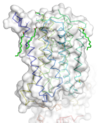The Human metabotropic glutamate receptor 5 transmembrane domain is a
Structure

Cross section view of mavoglurant in the binding pocket
Extracellular Domain
This is the
Binding Pocket
Function and Pathway
Disease
Parkinson's
Receiving and responding to extracellular messages is critical to the proper function of the nervous system. Glutamate is the major excitory neurotransmitter of the CNS, and metabotropic glutamate receptor 5 will play a major role in glutamate signaling. Metabotropic glutamate receptor 5 transmembrane domain is a homodimeric GPCR that resides in the cellular membrane [1]. This domain is a member of the Class C GPCR family and can further be categorized into the Group I subgroup. The transmembrane domain will signal through a Gq/11 pathway. mGlu5 will bind glutamate to the extracellular Venus flytrap domain and the signal will be transduced across the membrane to a heterotrimeric G protein, which will ultimately lead to calcium release and activation of PKC. This will elicit a excitory post-synaptic repose and modulate long term potentiation. Human metabotropic glutamate receptor 5 is found throughout the central nervous system. Areas containing high concentrations of this protein are often involved involved in emotions and higher cognition[2]. The localization of mGlu5 in the CNS and the presence of multiple domains makes mGlu5 a possible target for treating schizophrenia, Fragile X, depression, anxiety,and Alzheimer's disease[2].